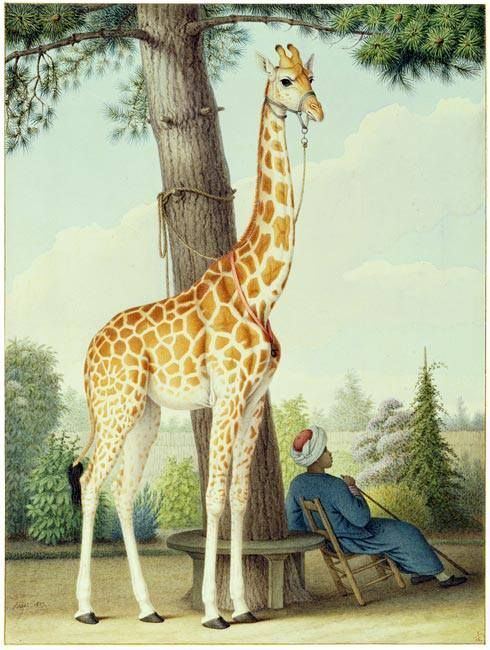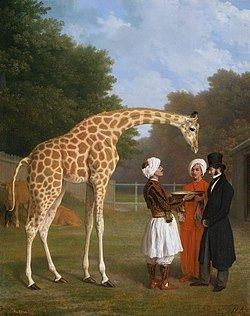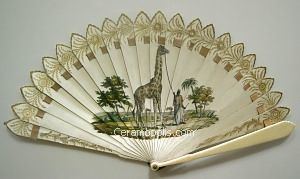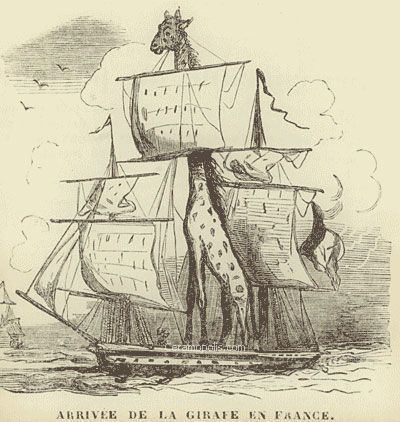Height 3.9 m | ||
 | ||
Died 12 January 1845, Paris, France | ||
Zarafa (1825 – 12 January 1845) was a female Nubian giraffe who lived in the Jardin des Plantes in Paris for 18 years. A gift from Muhammad Ali of Egypt to King Charles X of France, she was one of three giraffes Muhammad Ali sent to European rulers in 1827. These were the first giraffes to be seen in Europe for over three centuries, since the Medici giraffe was sent to Lorenzo de' Medici in Florence in 1486.
Contents

Biography

She was a present to Charles X of France from the Ottoman Viceroy of Egypt, Mehmet Ali Pasha. In 1824, the army of the Sultan of Turkey was engaged in fighting in the Greek War of Independence, and Sultan Mahmud II called upon the Pasha to send troops in support. The Greeks were supported by France. Bernardino Drovetti, the French consul-general in Egypt, persuaded the Pasha that an extraordinary present would encourage the King of France to stop supporting the Greeks.

She was captured as a young animal by Arab hunters near Sennar in Sudan and taken to Khartoum on the back of a camel, from where she was transported by boat down the Nile to Alexandria. She was accompanied by three cows that provided her with 25 litres of milk to drink each day.

From Alexandria, she embarked on a ship to Marseilles, with an Arab groom, Hassan, and Drovetti's Sudanese servant, Atir. As she was so tall, a hole was cut through the deck above the cargo hold through which she could poke her neck. After a voyage of 32 days, she arrived in Marseilles on 31 October 1826. Fearing the dangers of transporting her to Paris around the Iberian peninsula and up the Atlantic coast of France to the Seine, it was decided that she should walk the 900 km to Paris.

She over-wintered in Marseilles, where she was joined by the naturalist Étienne Geoffroy Saint-Hilaire for the walk. He ordered a two-part yellow coat for her, to keep her warm, and shoes for her feet. She set out on 20 May 1827, already 15 cm taller than when she arrived in Marseilles. She was accompanied by her cows and Saint-Hilaire, then aged 55, who walked with her. The walk to Paris took 41 days. She was a spectacle in each town she passed through, Aix-en-Provence, Avignon, Orange, Montelimar, Vienne. She arrived in Lyon on 6 June, where she was applauded by a crowd of 30,000.
She was presented to the King at the chateau of Saint-Cloud in Paris on 9 July 1827, and took up residence in the Jardin des Plantes. Now standing nearly 4 m high, Zarafa's arrival in Paris caused a sensation. Over 100,000 people came to see her, approximately an eighth of the population of Paris at the time. Honoré de Balzac wrote a story about her; Gustave Flaubert (then a young child) travelled from Rouen to Paris to see her. Hair was arranged in towering styles à la girafe; spotted fabrics were all the rage; porcelain and other ceramics were painted with giraffe images. She was painted by Jacques Raymond Brascassat.
She remained in Paris for a further 18 years until her death, attended to the end by Atir. Her corpse was stuffed and displayed in the foyer of the Jardin des Plantes in Paris for many years, before being moved to the Museum of Natural History of La Rochelle, where it remains.
Names
According to Étienne Geoffroy Saint-Hilaire, she was called The Beautiful Animal of the King (le bel animal du roi) during her trip from Marseille to Paris. The name “Zarafa” was retrospectively given to her by American author Michael Allin in his 1998 book Zarafa: A Giraffe's True Story, from Deep in Africa to the Heart of Paris. The name was derived from the African/Arabic word zarafa, meaning “giraffe”. Olivier Lebleu, author of the new preface to the second edition (2007) of the French journalist Gabriel Dardaud's book Une giraffe pour le roi (the first modern full-length work about France's first giraffe, it was originally published in 1985), has taken up the name “Zarafa,” as have several other recent authors, including Lebleu himself in his 2006 book Les Avatars de Zarafa. In addition, a 2012 French animation film calls her Zarafa, and even the museum in La Rochelle, where her mounted remains still greet visitors, now refers to her by this name, which thus can be seen to have passed into common usage. Another Arabic word with a similar pronunciation, meaning "charming" or "lovely one" was mentioned by Allin as a possible etymology, but this is ruled out as both words are spelled with different Arabic letters.
Other giraffe gifts by Muhammad Ali
Muhammad Ali Pasha also sent two other giraffes as gifts in 1827, one to George IV of the United Kingdom in London and the other to Francis I of Austria in Vienna. Like the giraffe sent to France, both inspired giraffe crazes in their respective cities. The Austrian giraffe joined the Emperor's menagerie at Schönbrunn Palace but survived for less than one year. Nevertheless, it lived on in the form of "Giraffeln" pastries, served until the beginning of the First World War. The English giraffe (or "cameleopard", echoing the terminology used by Pliny) joined the embryonic London Zoo in Regent's Park. It was painted as The Nubian Giraffe in 1827 by Jacques-Laurent Agasse, in an image that includes Edward Cross and, in the background, the giraffe's milk cows from Egypt. The English giraffe survived for less than two years, and was stuffed by John Gould.
